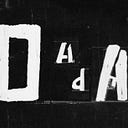DADAGAN at Miami Art Week
We basically exchanged our winter clothes for tropical attire and flew to Miami right after London to participate for the second time at CADAF, the Contemporary Art and Digital Art Fair, which was hosted for the first time during Miami Art Week.
Last Spring at CADAF New York we exhibited the work of one of our most prolific artists, María García. To keep things interesting this year, we introduced the DADAGAN, the bot trained by artist Alex Reben to make drawings from our dataset of over 115,000 works by human artists on our platform.
Alex created a video showing the evolution of the DADAGAN’s machine learning, which was shown in the digital video section of the fair.
We also issued three unique physical prints from conversations on DADA in which artists Boris Z. Simunich from Lima, LuShan from Hong Kong, and Isa Kost from Milan responded to work created by DADAGAN, to be sold together with their tokenized unique digital counterparts.
The prints look positively old school, particularly in the context of CADAF, which had several bright and shiny VR and AR exhibits. Our prints, in contrast, look like a watercolor, an abstract painting, and an engraving. Not very digital.
Yet they were all created digitally on DADA. They are unprecedented in that they involve artists responding to drawings made by a machine. Their traditional look belies something altogether modern, even futuristic.
The public at the fair had enormous fun trying to guess which part of the conversation was made by the DADAGAN and which by an artist of flesh and blood. Fascinatingly, the answer is not at all obvious. One of the drawings, in particular, stumped a lot of people, including experts on generative art. It turns out that people think that a robot’s drawings would be more perfect and precise, and human artists would be led by more expression and less perfection. You tell us:
But what we find especially moving about these “conversations” is that the three artists truly responded to DADAGAN as they respond to other artists on DADA. They did not try to upstage the GAN, or show it who’s the better artist. They truly responded to create something beautiful with DADAGAN in the true spirit of DADA: collaboration. It doesn’t matter if it’s with a machine or a human.
As for Miami Art Week itself, we wish we had been able to explore more of it. Judy gave a presentation hosted by Mana Tech about DADA as a real sharing economy and participated in a couple of panels at CADAF and Pulse Art Fair about the new era of digital art collecting.
It’s evident from the public’s response that people are fascinated with the intersection of art and tech, but not so clear that they are ready to invest in rare digital art yet. Still, CADAF is an enormous step to solidify and build this emerging market. We look forward to the next one!
